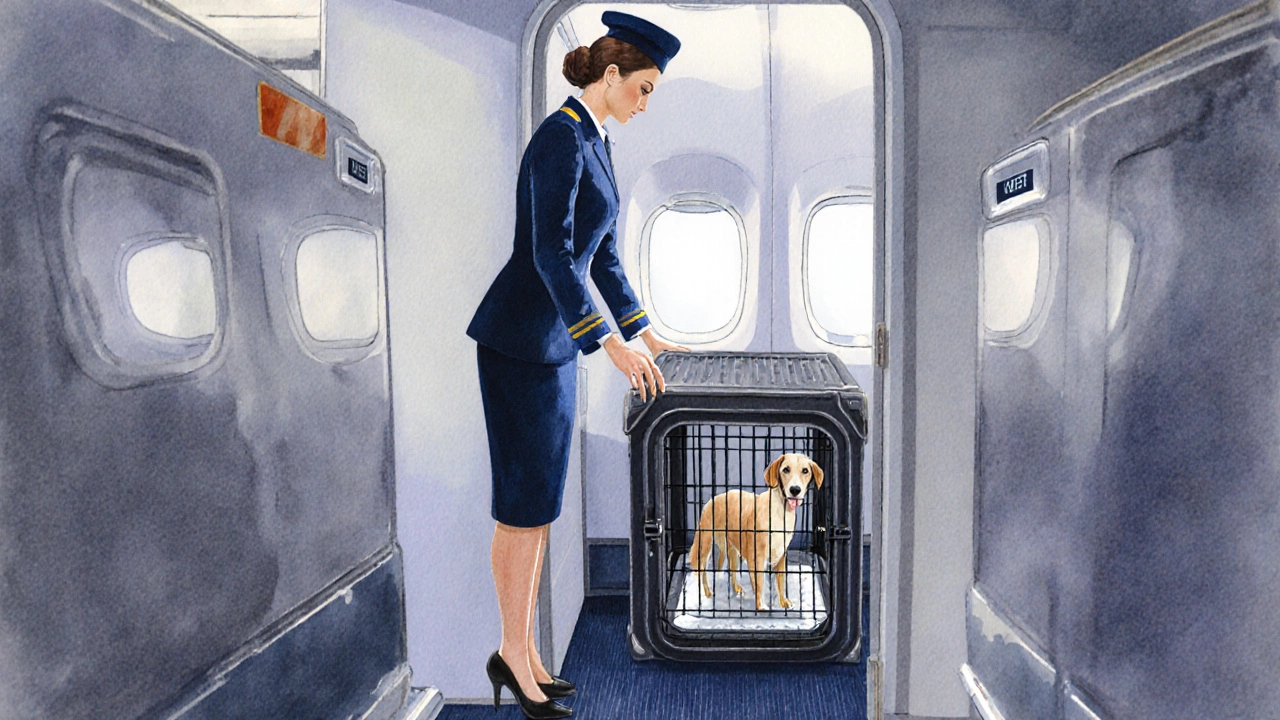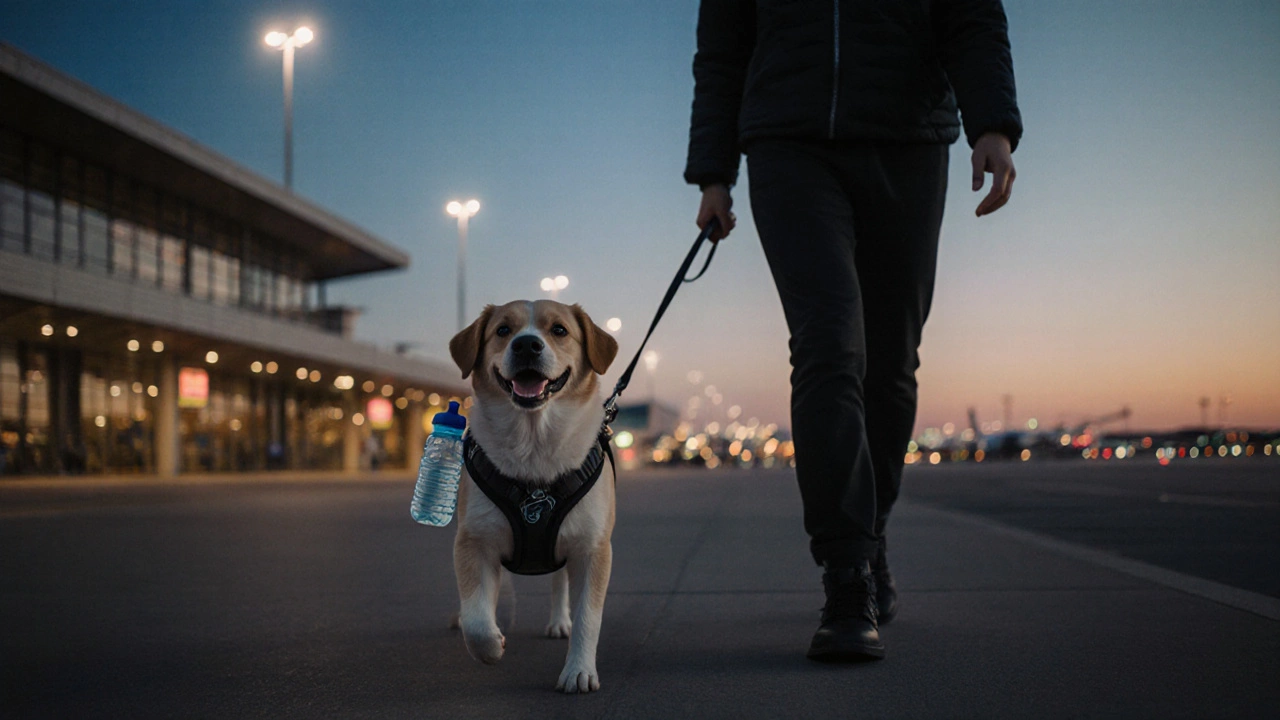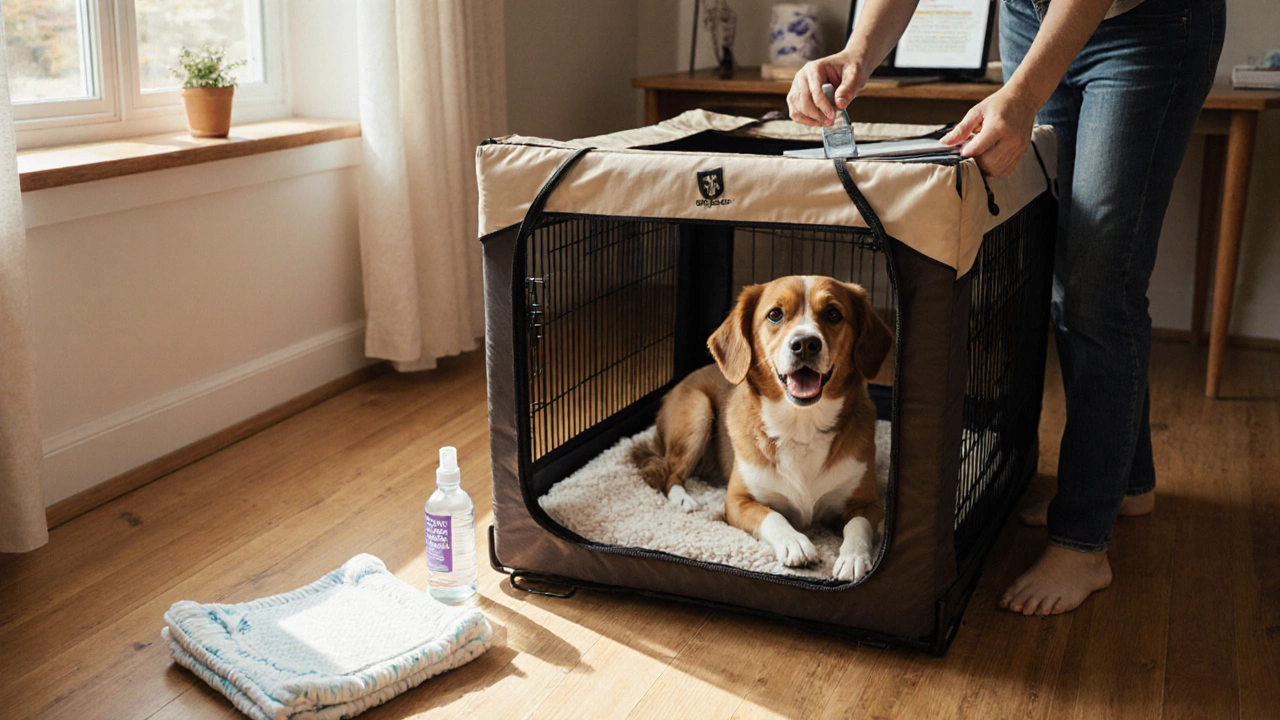Dog Travel Prep Calculator
Travel Information
Preparation Checklist
When you book a 10‑hour intercontinental trip, the biggest question on your mind is probably not the layover time or the seat pitch - it’s how your dog a loyal, four‑legged companion that thrives on routine and freedom will handle bathroom breaks in the sky.
Key Takeaways
- Check each airline’s pet‑policy early; most require a health certificate and limit in‑flight bathroom options.
- Choose a travel crate that fits airline dimensions and allows easy access for pee pads or diapers.
- Pack a portable dog pee pad, a reusable dog diaper, and a tiny water bottle for on‑board hydration.
- Plan pre‑flight potty stops, limit food 2‑3 hours before boarding, and keep water available but in small sips.
- After landing, give your dog a real walk and check for any signs of dehydration or stress.
Know the Airline’s Pet Policy
Every carrier has a airline pet policy a set of rules governing how pets travel, including crate size limits, documentation, and in‑flight bathroom allowances. Some airlines, like AirFly and SkyWings, permit a short walk in the cargo hold during long‑haul flights, while others, such as JetSet, keep pets in the cabin for the entire journey but forbid any on‑board relief area. Missed details can lead to denied boarding or an uncomfortable trip for your dog.
Action steps:
- Visit the airline’s website 2‑3 weeks before booking and download the pet‑travel PDF.
- Call the reservation desk to confirm the latest crate dimensions and whether a in‑flight pet relief area is available.
- Arrange a health certificate from your vet at least 10 days before departure; many airlines require a recent test for parasites and a proof of rabies vaccination.
Select the Right Containment
The travel crate is the cornerstone of a successful flight. A good crate should be sturdy, well‑ventilated, and fit under the seat or in the cargo hold according to the airline’s specifications. Look for crates made of hard‑plastic or metal with a secure latch and a breathable mesh panel.
Two popular options:
- Hard‑shell crate - ideal for cargo‑hold travel, offers maximum protection, but can be heavier.
- Soft‑sided carrier - allowed in‑cabin for small dogs, collapses for storage, but offers less structural support for turbulence.
Make sure the crate interior is lined with a washable pad, and keep the door opening wide enough to slide a pee pad or a diaper without disturbing your dog.

Prepare In‑Flight Bathroom Solutions
Because most airplanes pressurized cabins that circulate air every few minutes, the scent of urine can linger and upset both passengers and crew, it’s best to anticipate the need before it becomes an emergency.
Three practical tools:
- Portable dog pee pad a single‑use, absorbent pad that can be folded and placed inside the crate for emergency relief.
- Reusable dog diaper a snug, washable garment that catches urine and can be changed quickly at the lavatory.
- Travel hydration bottle a small, leak‑proof bottle with a bite‑friendly spout to sip water without spilling.
Below is a quick side‑by‑side comparison to help you decide which combo works best for your dog’s size and temperament.
| Feature | Portable Pad | Reusable Diaper | In‑flight Relief Area |
|---|---|---|---|
| Cost per flight | $0.75 (single‑use) | $12 (washable) | Free (if airline offers) |
| Space needed | Folded 4×4 inches | Fits snugly around mid‑size dogs | Requires crew assistance |
| Ease of disposal | Throw away in lavatory | Replace with fresh liner | Pet must be escorted to dedicated area |
| Best for | Short‑haul, low‑budget trips | Long‑haul, anxious dogs | Airlines that permit mid‑flight cargo‑hold walk |
Using In‑Flight Pet Relief Areas
If your airline provides a designated in‑flight pet relief area a small, enclosed space in the cargo hold where crew can briefly open the door for a pet to relieve itself, treat it like a pit stop on a road trip. Here’s how:
- Signal the flight attendant as soon as you sense restlessness - a pawing or whining usually means your dog needs to go.
- Allow the crew to open the bulkhead door; keep the crate door unlocked but latched so you can quickly slide it out.
- Stay calm and speak softly; a calm owner helps the dog relax even in a noisy cabin.
- After the quick break, wipe the crate floor with a disinfecting wipe, replace the pad if used, and close the crate securely before re‑seating.
Remember, not all airlines allow this service, so a backup plan (pad or diaper) is essential.
Hydration, Feeding, and Timing
Dehydration is a hidden danger on long flights. Keep a travel hydration bottle within reach and offer water in small sips every 2‑3 hours. Avoid letting your dog gulp large amounts just before boarding; that increases the need for a bathroom break early in the flight.
Food schedule tip: feed a light meal 4‑5 hours before departure, then a tiny snack 1‑2 hours prior. This timing reduces bowel movements during the ascent and descent, when pressure changes can cause discomfort.

Reducing Stress and Recognizing Signals
Long flights can trigger anxiety, which often manifests as pacing, whining, or excessive licking. A calm dog is more likely to hold it until the scheduled break. Use these stress‑reduction tricks:
- Place a familiar blanket or a piece of your clothing in the crate.
- Use a pheromone spray (e.g., Adaptil) to create a soothing scent.
- Play soft, white‑noise music through a small, battery‑powered speaker.
If you notice any of the following, act fast: sudden restlessness, frantic pawing at the crate floor, or a look of urgency in your dog’s eyes. Those are clear signs the portable pad or diaper should be deployed.
Post‑Flight Clean‑Up and Health Check
Once you land, give your dog a proper walk outside the terminal. This helps empty the bladder and eases any lingering tension. Check the coat for damp spots, and if you used a diaper, wash it immediately to prevent skin irritation. Offer water and a balanced snack, then monitor for any signs of dehydration-dry gums, lethargy, or excessive panting. If anything feels off, contact the vet within the next 24 hours.
Quick Checklist Before You Board
- Confirm airline pet policy and crate dimensions.
- Pack a portable pee pad, reusable diaper, and small hydration bottle.
- Bring a health certificate, vaccination record, and your dog’s ID tags.
- Feed a light meal 4‑5 hours before departure; limit water 30 minutes prior.
- Place a calming blanket, pheromone spray, and a toy inside the crate.
Frequently Asked Questions
Can I let my dog out in the aircraft bathroom?
No. Aircraft lavatories are not designed for pets, and most airlines forbid it. Use a portable pad, diaper, or the airline’s designated pet relief area if available.
What size crate is required for a medium‑sized dog?
Most airlines require a crate that is no larger than 18×14×10 inches (L×W×H) for cabin travel. For cargo‑hold travel, the limit can be up to 30×20×20 inches. Always double‑check the carrier’s specific limits.
How often should I offer water during a 12‑hour flight?
Offer a few sips every 2‑3 hours. Small, frequent drinks keep hydration steady without overfilling the bladder.
Is a reusable diaper safe for long‑haul flights?
Yes, as long as it fits snugly and you bring extra liners. Change it at the nearest lavatory and wipe the crate floor to avoid moisture buildup.
What if my dog gets anxious during takeoff?
Use a calming pheromone spray, a familiar blanket, and soft music. If anxiety is severe, consult your vet about a mild sedative before the trip.
With the right prep, a long‑haul flight becomes just another adventure for you and your dog. The key is to anticipate bathroom needs, bring the right accessories, and stay calm - your dog will follow your lead.
dog toilet on long flights doesn’t have to be a mystery; treat it like any other travel checklist and you’ll land with a happy, healthy pup.
